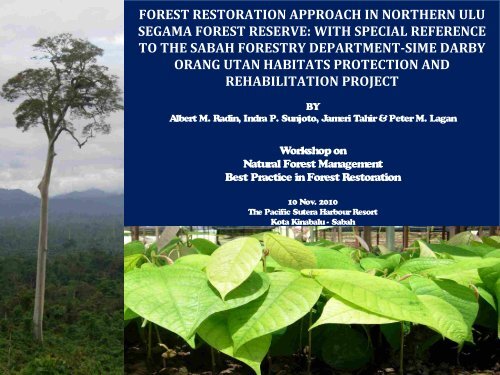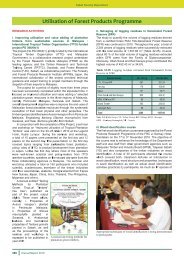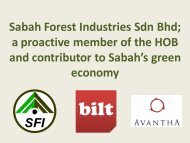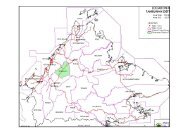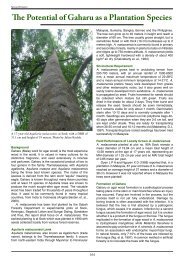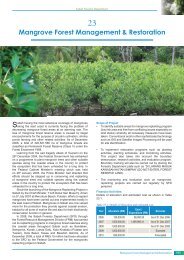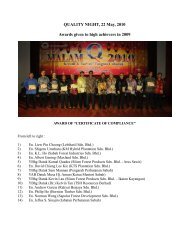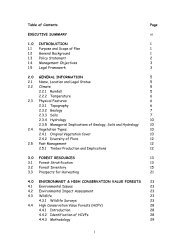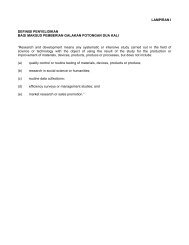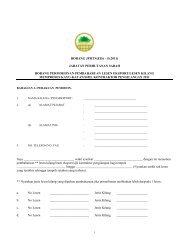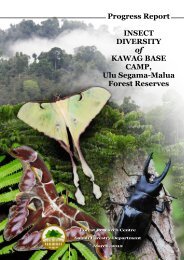(dipterocarps & non dipterocarps). - Sabah Forestry Department
(dipterocarps & non dipterocarps). - Sabah Forestry Department
(dipterocarps & non dipterocarps). - Sabah Forestry Department
- No tags were found...
Create successful ePaper yourself
Turn your PDF publications into a flip-book with our unique Google optimized e-Paper software.
FOREST RESTORATION APPROACH IN NORTHERN ULUSEGAMA FOREST RESERVE: WITH SPECIAL REFERENCETO THE SABAH FORESTRY DEPARTMENT-SIME DARBYORANG UTAN HABITATS PROTECTION ANDREHABILITATION PROJECTBYAlbert M. Radin, Indra P. Sunjoto, Jameri Tahir & Peter M. LaganWorkshop onNatural Forest ManagementBest Practice in Forest Restoration10 Nov. 2010The Pacific Sutera Harbour ResortKota Kinabalu - <strong>Sabah</strong>
INTRODUCTIONUSM SFMP – 15 th March 2006Area – 241,098 haManaged by SFD & YSObjective:protection, conservation &rehabilitation of vital ecosystem ofendangered wildlife – notably orang utan<strong>Sabah</strong> <strong>Forestry</strong> <strong>Department</strong> – Nov. 2010
INTRODUCTIONNUS – ± 12,000 haThe most degraded forest of Ulu Segama FRCaused: forest fire and past conventional harvestingWWF(Malaysia) wildlife census 2007 & 2008 - ± 400 orang utans trapped2006 – YS funded restoration activity at western NUS (980 ha restored)2007 – WWF (Malaysia) raised restoration funds for central NUS (450 harestored)<strong>Sabah</strong> <strong>Forestry</strong> <strong>Department</strong> – Nov. 2010
INTRODUCTION2008 – MoU and Agreement between SFD & SDPSBRestoration grant - RM 25 million for 10 yearsSFD-SDPSB Restoration & Protection of orang utanHabitats in NUSForest restoration, wildlife monitoring & EE<strong>Sabah</strong> <strong>Forestry</strong> <strong>Department</strong> – Nov. 2010
STRATEGIC PLANNING Steering Committee : SFD, SDPSB,YSD, YS,SWD, WWF Recruitment of (34) field staff – Aug. 2009 Area stratification based on AerialPhotograph (2006) Result: 46% secondary forest, 49% openarea (wild ginger, shrubs, creepers) & 5%oil palm Target to complete planting : 6-8 years Annual restoration area : 500 ha – 1000ha Focus restoration: planting higherproportion of orang utan’s food source Planting method : line planting Open area: single planting; spacing 7.5mx 5m; species: pioneer and wild fruit trees Secondary forest: cluster planting (4seedlings) in Y shape; spacing 12.5m x12.5m; species: <strong>dipterocarps</strong> & <strong>non</strong><strong>dipterocarps</strong><strong>Sabah</strong> <strong>Forestry</strong> <strong>Department</strong> – Nov. 2010
5° 05' 54.93"92 20 0 092 4 00 092 60 0 092 8 00 093 0 00 093 2 00 093 4 00 093 6 00 093 8 00 05 7 6 0 0 05° 11' 20.51"11 8° 00 ' 0 7. 4 8"11 8° 00 ' 3 9. 9 4"11 8° 01 ' 1 2. 4 0"11 8° 01 ' 4 4. 8 6"11 8° 02 ' 1 7. 3 3"11 8° 02 ' 4 9. 7 9"11 8° 03 ' 2 2. 2 5"11 8° 03 ' 5 4. 7 2"11 8° 04 ' 2 7. 1 8"11 8° 04 ' 5 9. 6 4"11 8° 05 ' 3 2. 1 0"STRATIFICATION MAPNORTHERN ULU SEGAMA-MALUA FR.SIME DARBY FOREST RESTORATION PROJECTScale: 1:60,00011 8° 06 ' 0 4. 5 7"11 8° 06 ' 3 7. 0 3"11 8° 07 ' 0 9. 4 9"11 8° 07 ' 4 1. 9 5"11 8° 08 ' 1 4. 4 1"5 7 6 0 0 05 7 4 0 0 05° 10' 47.95"5° 10' 15.39"112580L E G E N D:Compartment BoundaryInterpretation Based On Aerial PhotoSecondary Forest - 2,491 Ha.Shrub/Herbaceous Vegetation - 2,647 Ha.Oil Palm - 267 Ha.N0.7 0 0.7 1.4 Kilometers5 7 4 0 0 05° 09' 42.84"5 7 2 0 0 05° 09' 10.28"1143171134901176991194471205955 7 2 0 0 05° 08' 37.72"5 7 0 0 0 05° 08' 05.16"5 7 0 0 0 05° 07' 32.60"1156291166451185461224575 6 8 0 0 05° 07' 00.05"5 6 8 0 0 05° 06' 27.49"5 6 6 0 0 0JABATAN PERHUTANAN SABAHPUSAT PENYELIDIKAN PERHUTANANREMOTE SENSING & GIS LABMap Source:d:\frc\AVProject\.aprMap No.: PPP\RSGIS\0816Tarikh:03/06/20085 6 6 0 0 092 20 0 092 4 00 092 60 0 092 8 00 093 0 00 093 2 00 093 4 00 093 6 00 093 8 00 0
IMPLEMENTATION(A) Site Preparation Involve site reconnaissance andsurvey Required knowledge and skills ofsurvey Natural features adopt as blockingboundary Compassing: 8m interval for plantingline and 8m interval for plantingpoint Line opening: 2m width, slashingweeds and creepers Progress (Sept. 2009 – Oct. 2010) :445 ha Productivity: 6.25 mandays/ha Cost: RM 506.00/ha<strong>Sabah</strong> <strong>Forestry</strong> <strong>Department</strong> – Nov. 2010
IMPLEMENTATION(B) Silviculture treatment Removal of overhead shade andimpeding vegetation (woody vinesand climbing bamboo). Focus at secondary forests. To enhance growth and quality ofplanted seedling and potentialnatural regeneration. Manual cuts of climbers : less 5cmstump height and hanging 1m abovethe ground. Progress (Sept. 2009 – Oct. 2010) :395 ha. Productivity: 2.05 mandays/ha Cost: RM 174.00/ha.<strong>Sabah</strong> <strong>Forestry</strong> <strong>Department</strong> – Nov. 2010
IMPLEMENTATION(c) Comprehensive Restoration Plan Information of site-species matching Consideration: shade, topographic relief,drainage and general soil type Required knowledge and skills of tree ID andforest ecology Assessment for each planting point Site-species suitability guidance by FRC team Recommendation : point to be planted(method of planting : single or cluster), to beskipped & natural regeneration selection Wild fruit trees : < 20% Consideration: available seedlings stock Progress (Sept. 2009 – Oct. 2010) : 375 ha Productivity: 1.03 mandays/ha Cost: RM 85.00/ha<strong>Sabah</strong> <strong>Forestry</strong> <strong>Department</strong> – Nov. 2010
IMPLEMENTATION(D) Planting Modification of spacings and methods. Not uniform forest structure and fragmentedpocket forests. Spacing : 8m x 8m. Under canopy: cluster planting of 3 seedlings(<strong>dipterocarps</strong> & <strong>non</strong> <strong>dipterocarps</strong>). Open area: single planting (pioneers & wildfruit trees). Intensity: 156 points/ha. Average seedlings: 253 seedlings/ha. Application of fertilizer CIRP and NPK green(± 10 grams/seedlings). Slow progress due to productivity, seedlingsavailability and drought factor. Composition: 71% <strong>dipterocarps</strong> : 29%pioneers and fruits. 38% under canopy planting, 46% open areaplanting, 10% natural selection & 6%skipped 33 species planted Progress (Sept. 2009 – Oct. 2010) : 191 ha. Productivity: 5.6 mandays/ha Cost: RM 1,038.00/ha.<strong>Sabah</strong> <strong>Forestry</strong> <strong>Department</strong> – Nov. 2010
LIST OF PLANTED SPECIESNo Vernacular name Group No Vernacular name Group1 Seraya melantai Dipterocarp 18 Nyatoh sidang Non dipterocarp2 Seraya tembaga Dipterocarp 19 Gaharu Non dipterocarp3 Seraya majau Dipterocarp 20 Medang pengulobon Non dipterocarp (wild fruit)4 Seraya punai Dipterocarp 21 Telisai @ ketapang Non dipterocarp (wild fruit)5 Kapur paji Dipterocarp 22 Kayu malam Non dipterocarp (wild fruit)6 Kawang pinang Dipterocarp 23 Meritam Non dipterocarp (wild fruit)7 Kawang jantung Dipterocarp 24 Kedondong Non dipterocarp (wild fruit)8 Pangiran kesat Dipterocarp 25 Kembayau (kedondong) Non dipterocarp (wild fruit)9 Pangiran gajah Dipterocarp 26 Ranggu Non dipterocarp (wild fruit)10 Selangan batu laut Dipterocarp 27 Sentang / limpaga Non dipterocarp (wild fruit)11 Obah suluk Dipterocarp 28 Belimbing hutan Non dipterocarp (wild fruit)12 Belian Non dipterocarp 29 Mata kucing Non dipterocarp (wild fruit)13 Pulai Non dipterocarp 30 Mempening Non dipterocarp (wild fruit)14 Putat paya Non dipterocarp 31 Laran Non dipterocarp (wild fruit)15 Pelajau Non dipterocarp 32 Binuang Non dipterocarp (wild fruit)16 Sengkuang Non dipterocarp 33 Kulimpapa Non dipterocarp (wild fruit)17 Mengaris Non dipterocarp
IMPLEMENTATION(E) Maintenance Reconditioning by elimination ofcompetitor vegetation, as to boost thegrowth of planted seedlings. Census of survival seedlings. Activities: planting line clearing, circleweeding fertilizing & resupply deadseedling. Application of herbicide – Sentry(strictly in accordance with FSCstandard). Maintenance intensity : 13 rounds (4rounds for each 1 st & 2 nd year, 3 roundsin 3 rd year & 2 rounds in 4 th year). Productivity: 3.2 mandays/ha Cost: RM 300.00/ha/round Considering of 13 rounds: RM3,900.00/ha (for four years)<strong>Sabah</strong> <strong>Forestry</strong> <strong>Department</strong> – Nov. 2010
IMPLEMENTATIONSurvival rate Survival rate one year after planting : 67% 52% mortality occured at open planting and 48%under canopy plantingContributing factorSingleplantingPercentage of mortality (%)Clusterplanting<strong>Sabah</strong> <strong>Forestry</strong> <strong>Department</strong> – Nov. 2010AverageDrought 53.00 34.00 44.00Human factor 0.50 - 0.01Wildlife disturbanceForest debrisOthers (handling, weedscompetition)Total0.50 1.00 0.051.00 1.00 0.0845.00 64.00 55.86100.00 100.00 100.00
Weeds and creepers competition
Workers carelessnessSambar deer browsing
NURSERY MANAGEMENT Location: Compartment 116. Full operation : May 2010. Cost development: RM 326,000.00.Management: contracted to AYEnterpriseSupply seedlings to the project:RM3.00/seedlings.Capacity: 200,000 seedlings at onetime .Seeds source: Ulu Segama FR,Tawau, Kunak, Kinabatangan,Telupid & Sandakan.Current stocks: 115,000 seedlings59 mixed species of <strong>dipterocarps</strong>,<strong>non</strong> <strong>dipterocarps</strong>, pioneers andwild fruit species<strong>Sabah</strong> <strong>Forestry</strong> <strong>Department</strong> – Nov. 2010
AVAILABLE SEEDLINGS AT PROJECT NURSERYNo Vernacular name Group No Vernacular name Group1 Seraya melantai Dipterocarp 31 Pelajau Non dipterocarp2 Seraya tembaga Dipterocarp 32 Sengkuang Non dipterocarp3 Seraya majau Dipterocarp 33 Keranji Non dipterocarp4 Selangan batu gelombang Dipterocarp 34 Mengaris Non dipterocarp5 Seraya daun emas Dipterocarp 35 Nyatoh sidang Non dipterocarp6 Seraya kuning barun Dipterocarp 36 Nyatoh bulu Non dipterocarp7 Seraya punai Dipterocarp 37 Perupok Non dipterocarp8 Seraya kuning siput Dipterocarp 38 Medang pengulobon Non dipterocarp (wild fruit)9 Seraya lenggai Dipterocarp 39 Telisai @ ketapang Non dipterocarp (wild fruit)10 Seraya timbau Dipterocarp 40 Tampoi Non dipterocarp (wild fruit)11 Kapur paji Dipterocarp 41 Kayu malam Non dipterocarp (wild fruit)12 Kapur gumpait Dipterocarp 42 Terap ikal Non dipterocarp (wild fruit)13 Kawang pinang Dipterocarp 43 Terap togop Non dipterocarp (wild fruit)14 Kawang jantung Dipterocarp 44 Meritam Non dipterocarp (wild fruit)15 Kawang burung Dipterocarp 45 Kedondong Non dipterocarp (wild fruit)16 Pangiran kesat Dipterocarp 46 Penarahan Non dipterocarp (wild fruit)17 Pangiran gajah Dipterocarp 47 Rambai Non dipterocarp (wild fruit)18 Keruing putih Dipterocarp 48 Kembayau (kedondong) Non dipterocarp (wild fruit)19 Keruing belimbing Dipterocarp 49 Jering Non dipterocarp (wild fruit)20 Keruing merah Dipterocarp 50 Ranggu Non dipterocarp (wild fruit)21 Keruing gondol Dipterocarp 51 Kembang semangkuk jantan Non dipterocarp (wild fruit)22 Keruing daun besar Dipterocarp 52 Sentang / limpaga Non dipterocarp (wild fruit)23 Keruing merekah Dipterocarp 53 Belimbing hutan Non dipterocarp (wild fruit)24 Selangan batu laut Dipterocarp 54 Mata kucing Non dipterocarp (wild fruit)25 Selangan batu terendak Dipterocarp 55 Mempening Non dipterocarp (wild fruit)26 Obah suluk Dipterocarp 56 Laran Non dipterocarp (wild fruit)27 Belian Non dipterocarp 57 Binuang Non dipterocarp (wild fruit)28 Pulai Non dipterocarp 58 Kulimpapa Non dipterocarp (wild fruit)29 Rengas Non dipterocarp 59 Gaharu Non dipterocarp30 Putat paya Non dipterocarp
INFRASTRUCTURE(i) Base camp (1) unit office building cum quarterscompleted in March 2010. Development cost: RM 319,000.00.Centre of administration andmanagement.(ii) Roads Main road : 20 km Inter block roads Maintained by SFD team (1) unit excavator, (1) motorgrader,(1) unit back hoe loader & (1) unitdump truck<strong>Sabah</strong> <strong>Forestry</strong> <strong>Department</strong> – Nov. 2010
WILDLIFE MONITORINGDone by SFD’s Wildlife Unit.Collecting basic wildlifeinformation at working area (Cpt.112).Result: abundance of smallmammals, RTE species alsoobserved (orang utans, cloudedleopards & sun bears).<strong>Sabah</strong> <strong>Forestry</strong> <strong>Department</strong> – Nov. 2010
BASIC WILDLIFE INFORMATION AT COMPARTMENT 112No Species Notes1 Orang utan Estimated about 5 to 10 individuals2 Wild boar Very common at common boundary with estate3 Sambar deer Dominating open area4 Leopard cat Viable population at disturbed forest5 Porcupine Very common at open area6 Mouse deer Common at secondary forest7 Moon rat Common at flat and dry area8 Monitor lizard Very common at water logged area9 Common tree shrew Very common at secondary forest10 Large tree shrew Common at secondary forest11 Small spiny rat Common at secondary forest12 Pen tail shrew Common at secondary forest13 Slender tree shrew Common at disturb forest14 Plaintain squirrel Common at secondary forest15 Pangolin Common at open and dry area16 Clouded leopard Estimated 1 to 2 individuals17 Sun bear Estimated 1 to 2 individuals
ISSUES AND DISCUSSIONS(i) Target vs Reality Target for annual planting : 500ha – 1000ha. 6-8 years to complete 5,400ha (started 2008). Achievement : 191 ha (Sept. 2009-Oct.2010). Issues of low performance: staff recruitment, inadequateplanting material, limited species diversity & prolongeddrought. Mitigation measures:(i) Reconstruct PoP – a realistic target of 500 ha/annum(ii) Increase nursery capacity(iii) Engage local communities of Segama to supplyseedlings(iv)Continuous SFD’s capacity building(v) Increase SFD’s staff number for skills required incomponents, i.e.: survey, CRP & supervisor(vi)Contract out planting and maintenance component tolocal entrepreneurs & local communities of Segama<strong>Sabah</strong> <strong>Forestry</strong> <strong>Department</strong> – Nov. 2010
ISSUES AND DISCUSSIONS(ii)Polythene bag size The usage of bigger poly-bag size : 6” x 9”.Reasons: better rooting system and upkeep nutrient levelfor open planting .Issues: more weights and affecting productivity perhectare.Mitigation measures:(i) Improve planting medium composition to reduce polybag’sweight(ii) Application of ‘tray system’ for seedlings transportation<strong>Sabah</strong> <strong>Forestry</strong> <strong>Department</strong> – Nov. 2010
ISSUES AND DISCUSSIONS(iii) ProductivitySlow progress due to lower productivityof SFD’s contract staff.Factors: different background, skills,incompetent & problematic .Mitigation measures:(i) Termination of problematic staff –(6) people sacked out.(ii) Minor revisions of productivityincentives.(iii) Continuous capacitybuilding – on the job training<strong>Sabah</strong> <strong>Forestry</strong> <strong>Department</strong> – Nov. 2010
ISSUES AND DISCUSSIONS(iv)Seed sourcesInadequate planting material impedes plantingprogress.Issue: seeds production is influenced byweather pattern (little drought encourageflowering & fruiting of <strong>dipterocarps</strong>) and verylocalised .Mitigation measures:(i) Encourage nursery operator to outsource seeds procurement from other district.(ii) Nursery operator engage with localcommunities – traditional knowledge oflocal flowering and location.(iii) Seeds supply from FRC team.(iv) Training on the seeds collectiontechnique by FRC team.(v) Establishment of phenology plots withinthe Ulu Segama FR – assisted by FRC team.<strong>Sabah</strong> <strong>Forestry</strong> <strong>Department</strong> – Nov. 2010
ISSUES AND DISCUSSIONS(v)SpacingRecommended planting space in planning phase:-(a) Open areas: 7.5m x 5m - single planting;(b) Secondary forests: 12.5m x 12.5m – cluster plantingIssue: not practical for big scale restoration programmeReason: forest structure is not uniform and arefragmented pockets of forests.Mitigation measures: modified to 8m x 8m withcombination single and cluster planting.<strong>Sabah</strong> <strong>Forestry</strong> <strong>Department</strong> – Nov. 2010
ISSUES AND DISCUSSIONS(vi) Higher mortality Higher mortality rate: 33% after one year planting. Contributor factors: weeds competition, seedlingshandling and drought phenome<strong>non</strong>. Recommended mitigation measures:- Reduce number of carried poly-bags to lightenknapsacks weight– can jeopardize productivity,increase mandays/ha. Control the length of planting line ~ 500m – 800m.Intensive maintenance programme by shorteninginterval period– can affect cost/haProhibition of planting during prolonged droughtIncrease efficiency of herbicide application<strong>Sabah</strong> <strong>Forestry</strong> <strong>Department</strong> – Nov. 2010
CONCLUSIONStrategic planning provides guidance withsome improvements during theimplementation phase.Some issues are recognized and mitigationmeasures are taken into action to increaseproject performance.Size of rehabilitated area is not merely themeasurable achievement but forests qualityand its ecosystem functions must be addressproperly.<strong>Sabah</strong> <strong>Forestry</strong> <strong>Department</strong> – Nov. 2010
THANK YOU


